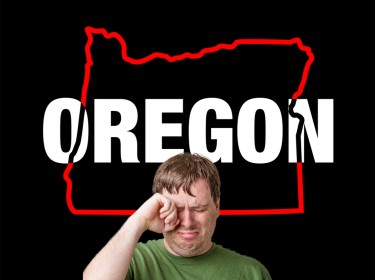
Once again, Oregon’s cannabis producers have faced an oversupply issue, as revealed in a recent report. This perpetuates the ongoing challenge of excess marijuana within the state’s regulated cannabis industry.
Throughout much of the current year, analyses of Oregon’s cannabis production indicated a downward trajectory compared to the previous year, resulting in a slight uptick in prices. However, a November 20 report by state economists Mark McMullen and Josh Lehner unveils that the fall harvest of outdoor cannabis this year surpassed the production levels recorded in 2022.
The economists noted, “During the first nine months of the year, the marijuana harvest was nine percent lower than the previous year and 15 percent lower than the record crop in 2021. As the market seemed to be adjusting, prices were stabilizing. However, this changed with the substantial outdoor harvest in October, which is 15 percent larger than the previous October.”
Oregon’s cannabis cultivators have consistently outpaced consumer demand for at least five years. Mark Pettinger, a spokesperson for the Oregon Liquor and Cannabis Commission (OLCC), acknowledged last year that part of the problem stems from the challenges operators and regulators face in predicting cannabis production. Due to a significant portion of the state’s cannabis being harvested simultaneously, the industry struggles to adapt swiftly to evolving market conditions at both the wholesale and retail dispensary levels.
Pettinger explained, “About 85% of the crop is grown outdoors, harvested in October, but planning for planting takes place the following April. This timeline doesn’t provide sufficient opportunity to accurately assess how the previous fall’s harvest impacts the market.”
Economic Downturn Spurs Financial Struggles in Cannabis Industry
The surplus of cannabis in Oregon’s regulated market has wreaked havoc on the industry over the years. The oversupply has led to a sharp decline in wholesale cannabis and retail product prices. While consumers welcome the lower prices, cannabis companies are grappling with shrinking profit margins and, in some cases, no profits at all. Consequently, producers, wholesalers, and retailers across the state are struggling to stay financially afloat.
Beau Whitney, an economist based in Portland who monitors cannabis prices in Oregon and the United States, revealed that over one-third of respondents in a cannabis industry survey reported difficulty in paying taxes. A larger percentage expressed challenges in managing debt.
Whitney emphasized that the timing of the latest report on Oregon’s abundant fall harvest is particularly unfavorable. “People are walking away from cannabis licenses or selling them for pennies on the dollar,” Whitney told Willamette Week.
The decline in cannabis prices is also impacting the collection of Oregon’s cannabis taxes. Tax delinquencies have increased throughout the state, and cannabis tax revenue has fallen short of estimates for four of the past five quarters.
Whitney suggested that Oregon regulators could boost cannabis prices by implementing production controls, such as limiting the number of licenses or their capacity. However, Pettinger of the OLCC argued that the current oversupply is the result of deliberate policy decisions and the federal government’s ongoing refusal to legalize cannabis. Federal legalization would open up markets nationwide for Oregon’s cannabis growers.
“The state, the industry, and elected officials envisioned Oregon becoming a net exporter under federal legalization,” Pettinger explained. “The oversupply we’re seeing underscores the dilemma in all states where marijuana is legal—it’s akin to an Iowa corn farmer only being able to sell his crop within Iowa.”
Fiscal Impact on Oregon’s Cannabis Tax Landscape
In response to the instability caused by declining cannabis prices in Oregon, two prominent industry groups recently merged. The Oregon Cannabis Association and the Cannabis Industry Alliance of Oregon formally announced their merger last month, following unanimous votes by both organizations’ boards of directors.
Hunter Neubauer, a board member of the newly combined trade group, emphasized the wealth of knowledge and passion within Oregon’s cannabis industry. He stated, “Those individuals need a unified platform where they can contribute their resources, become members, and collectively advocate for sensible regulations and future growth opportunities in the industry, particularly when engaging with policymakers in Salem.”
The consolidated organization has adopted the name Cannabis Industry Alliance of Oregon and proudly represents over 500 member businesses in the state’s licensed cannabis market, contributing approximately $1 billion in annual sales.
Mike Getlin, the board chair of the Cannabis Industry Alliance of Oregon, expressed the collective commitment to preserving and nurturing the valued cannabis community. He highlighted the group’s vision for more than just a proliferation of minimum-wage jobs controlled by out-of-state and potentially overseas financial interests. “This fight is truly about ensuring the survival and prosperity of a thriving and locally rooted industry,” Getlin conveyed to local media.
Industry Consolidation Aims to Tackle Challenges
Recognizing the pressing challenges posed by the persistent oversupply, efforts are underway within Oregon’s cannabis sector to address the issues head-on. Stakeholders are exploring innovative solutions, with a focus on collaboration and strategic consolidation, as they seek to navigate the intricate landscape of fluctuating prices and market dynamics.
In recent developments, industry leaders are considering various approaches to streamline operations and enhance the overall resilience of the cannabis market in the face of ongoing uncertainties. As the industry seeks to adapt to changing conditions, collaborative initiatives and strategic partnerships are emerging as crucial components of a collective strategy to foster sustainability and growth. Stay tuned as the industry continues to evolve in response to the complex interplay of economic forces and regulatory landscapes.
Bottom Line
In 2023, Oregon’s cannabis industry grapples with a persistent oversupply issue, highlighted once again in a recent report. Despite initial signs of a downward trajectory in cannabis prices throughout the year, a substantial outdoor harvest in October disrupted the market’s stabilization. This oversupply has led to financial hardships for businesses, with declining profit margins and tax revenue shortfalls. The industry’s response includes strategic consolidation, as demonstrated by the merger of the Oregon Cannabis Association and the Cannabis Industry Alliance of Oregon, forming the Cannabis Industry Alliance of Oregon. This consolidation aims to unite resources for collective advocacy and promote sensible regulations. As stakeholders collaborate to address challenges and streamline operations, the industry’s future evolution in the face of economic forces and regulatory landscapes remains a dynamic narrative, emphasizing the pursuit of a resilient and locally-rooted cannabis community in Oregon.
OREGON’S SUPPLY PROBLEMS, READ ON…
HERE IS ONE WAY TO FIX OREGON’S CANNABIS SURPLUS PROBLEM!
- SEO Powered Content & PR Distribution. Get Amplified Today.
- PlatoData.Network Vertical Generative Ai. Empower Yourself. Access Here.
- PlatoAiStream. Web3 Intelligence. Knowledge Amplified. Access Here.
- PlatoESG. Carbon, CleanTech, Energy, Environment, Solar, Waste Management. Access Here.
- PlatoHealth. Biotech and Clinical Trials Intelligence. Access Here.
- Source: http://cannabis.net/blog/news/selling-cannabis-licenses-for-pennies-on-the-dollar-oregons-outdoor-harvest-was-so-massive-it-c




